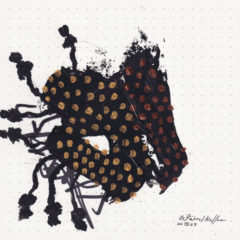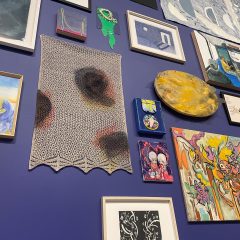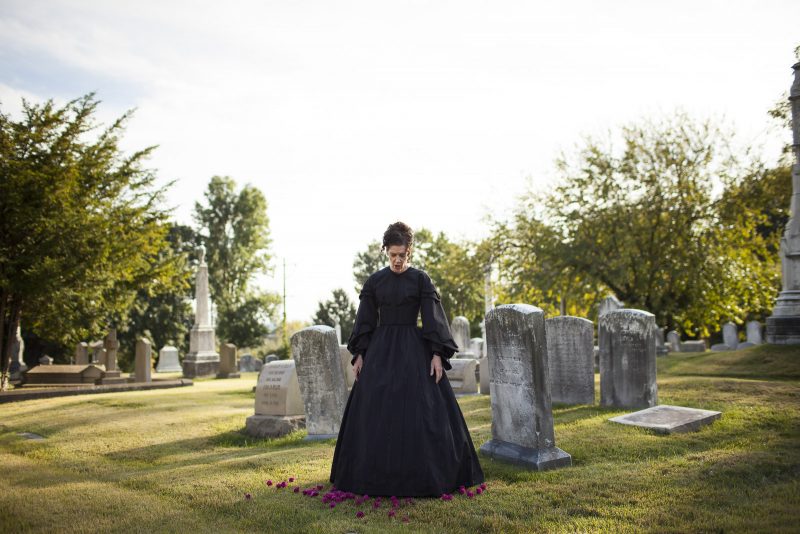
[Originally published July 2006]
Here are links to Part 2 and Part 3 of the interview.
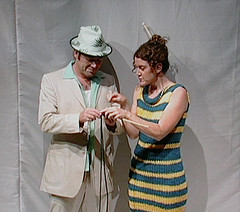
McDonald teaching an audience member how to knit in Drown’d in mine own Tears at the 2005 Fringe Festival.
Like Garrison Keillor, performance artist Martha McDonald is an English major who tells stories and sings a little. But unlike the commercially successful Keillor—with his tame material about Lutherans and cowboys—McDonald’s one-woman shows are a loopy mix of baroque opera and yarns about mermaids, Greek goddesses and women who knit dresses that entrap them in their homes.
Now McDonald performs her new work Lament, a collaboration with artist Katie Holten, at Bartram’s Garden after William Pope L.’s Black Factory event. Lament is part of the Institute of Contemporary Art’s “Soft Sites” exhibition.
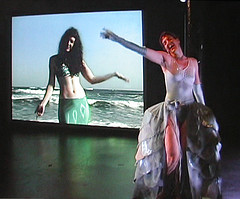
Singing a duet with herself in Girls on the Rocks at American Living Room Festival at HERE Art Center, NYC, 2003
Energetic, studious, verbally adept and possessed of a self- deprecating humor, McDonald onstage is a little like McDonald in the real world—only hugely pumped up. In works that swing from monologue to sashaying around like a Las Vegas showgirl and singing a duet with herself on video, McDonald observes herself and womankind through the small end of the telescope and questions what it is to be caught up in an eddy of love, loss and regret.
The artist (whose day job is freelance writing grant proposals for nonprofit agencies) is exquisitely vulnerable, singing opera arias in a wavering mezzo-soprano and confessing all in her partly autobiographical works.
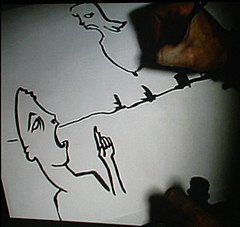
McDonald often works with artists in her projects. This is a video projection of a hand-drawn sequence that was used as a backdrop in Girls on the Rocks.
I met McDonald in her backyard garden recently where the bee balm plant and butterfly bush hummed with six-legged critters and the tomato plants are shoulder high.
Roberta: Have you performed outside before?
Martha: This is really different for me. It’s an intimate walking tour of the gardens, the meadow and wooded glen, where I’ll sing. Outside is perfect. I like to take people on tour and connect with them. I want to get away from opera’s ‘park and bark’ (i.e., stand and sing).
What will you do?
Katie Holten made little sculpture ‘seeds,’ and I’ll be activating them by planting them. I don’t want to say too much. It’s exploring plants that have gone extinct.
Storytelling is a big part of your performance. Tell me some of the stories.
There’s a personal story with my trying to transplant a plant from my grandfather’s garden into my own and my sense of loss. The Franklinia tree. At this point it’s extinct in the wild. Bartram rescued it from extinction. And there’s a story about peonies linked to royalty in China.
What’s the costume?
I’ll keep it simple. I’m making it.
What’s the lament?
Henry Purcell’s Lament—actually it’s called The Plaint. I’ll be unaccompanied.
You said the lament was a natural song form for you.
I find it easy to access sorrow. Maybe that’s maudlin Irish sentimentality—the hole in my heart that I access. I bring [to the song] all the personal losses I’ve had over the years.
—
[This artist interview was originally published on Artblog in 2006, you can follow the rest of Roberta and Martha’s conversation in the original Artblog posts also from that year — Part 2 and Part 3.]



